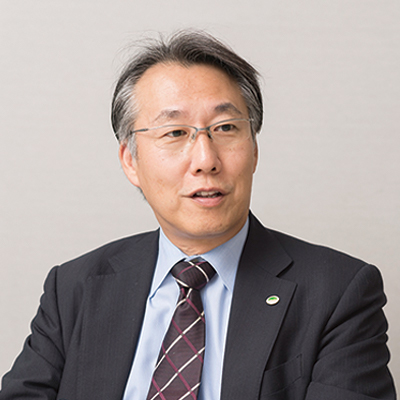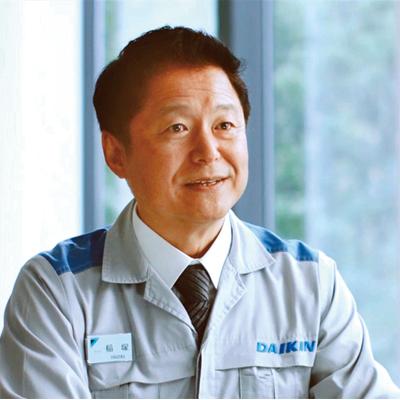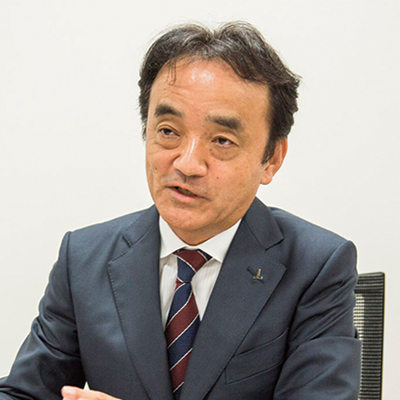COVER STORY:ACTIVITIES1
Next-generation Factory Utilizing the IoT through Collaborative Creation
Manufacturing urgently needs to find ways to deal with shorter development cycles and high-mix low-volume manufacturing. Hitachi is actively engaged in improving productivity and transferring skills using its IoT platform “Lumada”. This article presents specific examples and future strategies for digitalization.
To enable the manufacturing industry to respond to rapid changes in the market environment amid intensifying global competition, initiatives for digital innovation using technologies such as big data analytics and artificial intelligence (AI) are picking up pace. Japanese manufacturing, meanwhile, is recognized around the world for its skill at producing high-performance, high-quality products. This skill is thought to be a reflection of the artisanship and pride with which workers strive to always produce products that delight customers, never cutting corners even when producing standardized products, and engaging in continuous improvement (“kaizen”) in the workplace to reduce variability to a bare minimum.
Even as global competition in manufacturing becomes increasingly intense, the build-up of distinctively Japanese skills and expertise that warrant the term “craftsmanship” has yet to subside. In an era when a variety of advanced technologies are making it possible to digitalize and visualize the tacit knowledge in that workplace, there are growing opportunities for further boosting competitiveness in global markets.
Having recognized these needs of the manufacturing industry, Hitachi is taking full advantage of its ability to combine control and operational technology (OT) with information technology (IT) as it engages in many collaborative creation projects to bring out the potential in customers to further improve productivity and quality, and to support skills transfer and other activities. This article describes two of those collaborative creation projects, with Daikin Industries, Ltd., and Okuma Corporation, respectively.
 Kazunobu Morita
Kazunobu Morita
Chief Lumada Officer, Industry & Distribution Business Unit and General Manager, Industrial Manufacturing Solution Division, Industrial Solutions Division, Hitachi, Ltd.
Kazunobu Morita, (Chief Lumada Officer, Industry & Distribution Business Unit and General Manager, Industrial Manufacturing Solution Division, Industrial Solutions Division, Hitachi, Ltd.) who has supervised numerous collaborative creation projects that use Hitachi’s IoT platform Lumada recalls the project as follows.
“Our involvement with Daikin began as the result of a recommendation from the Daicel Corporation, with whom we had already launched a collaborative creation project. Both companies shared the common objectives of wanting to use the IoT to strengthen their manufacturing sites’ platforms and to extend Japan’s excellent technologies to other countries. It was this that led to our embarking on collaborative creation with Daikin.”
Daicel boasts a broad business portfolio extending from chemical products to gas-driven inflators for automobile airbags. The collaborative creation with Daicel commenced in February 2015 and involved the development of an image analysis system that used multiple cameras to detect signs of deviations in front-line worker activities and facility failures. With adoption of the system already underway at several plants both in Japan and worldwide, it is making a major contribution to standardizing product quality at a global level and to improving productivity. It was thanks to the executives at Daicel who wanted to see this work utilized, not only in their own company, but also at other Japanese manufacturers that are serious about manufacturing, that the new collaborative creation project between Daikin and Hitachi came about.
Daikin is a leading global company of air conditioners that has operations in more than 150 different countries around the world, with more than 70% of its sales coming from outside Japan. Because it has more than 80 sites outside Japan, it sees work skills transfer and the further improvement of productivity and quality across these different countries and regions as important challenges (see Figure 1).
Mr. Morita comments, “As a first step toward the goal of creating next-generation factories, the collaborative creation project started by attempting to utilize Hitachi’s IoT technology for the skills transfer in brazing, the most basic skills used in the manufacture of air conditioners.”
The interior of an air conditioner is packed with copper pipes that carry the coolant. These copper pipes are sensitive to heat and joining them requires a skill called brazing that involves melting a filler metal with a lower melting point than the material being joined and allowing it to flow into the joint gap (see Figure 2). This is an important skill that influences product quality and one that cannot be mechanized. Accordingly, a small number of meisters (expert workers) travel between the plants scattered around the world to conduct training. Unfortunately, there were concerns about the lack of efficiency in this skills transfer process because of the many aspects of brazing that cannot be handed on in written form or through practice alone.
Instead, Hitachi used the image analysis system solution core for Lumada honed through collaborative creation with Daicel as the base for developing the Brazing Skills Training Support System, which can make quantitative assessments of the meisters and trainees on the basis of the “man, machine, and material (3M)” factors of production. Specifically, the system uses cameras and sensors to collect and digitalize time-series data on the work of meisters, including their hand motions, gas torch angle, angle at which wire feeding and the materials being joined are oriented, and the temperature distribution. This is then used as the basis for a virtual comparative display that shows how the work of a trainee differs from that of the meister.
Mr. Morita explains, “We worked in tandem on putting the technology together, with Daikin identifying 18 criteria for evaluating work and Hitachi developing the associated sensing and data analysis techniques. We developed new techniques for evaluating things like how the torch angle changes the temperature distribution, and succeeded in the previously difficult task of capturing information on an expert’s skill and using this for comparison to identify areas where trainees can improve. Because the system provided them with a numerical basis for giving advice, the meisters were delighted when it became possible to quickly and efficiently perform training that had been so troublesome in the past.”
The system has already commenced operation at Daikin’s Shiga Plant and will be progressively rolled out to other plants in Japan and worldwide with the intention of it leading to the achievement of uniform levels of quality throughout the world and providing an efficient way to raise skill levels and train global staff, such as by allowing meisters to support training at overseas plants while remaining in Japan.
Daikin is a leading global company of air conditioners that has operations in more than 150 different countries around the world, including more than 80 plants outside Japan. (The photographs show its Shiga Plant.)
Okuma is a leading Japanese machine tool manufacturer known for its relentless focus on technology and for developing its major core technologies in-house. In order to cope with all of the meticulous requirements of their diverse customers, machine tool manufacturers are the epitome of ultra-high-mix low-volume manufacturing that processes and assembles several thousand to several tens of thousands of parts. In working toward implementing high-efficiency and smart next-generation factories, Okuma has been operating its “Dream Site1” (DS1) factory since 2013 to produce multitasking machines and medium- and large-sized lathes. In 2017, Okuma constructed its new “Dream Site2” (DS2) factory to produce parts for small- and medium-sized lathes that feature advances in the areas of the IoT and the automation and unmanned operation of production equipment. In the planning stages of DS2, Okuma approached Hitachi with a proposal for a joint demonstration experiment that involved using the IoT for mass customization with the aim of doubling productivity and halving production lead times compared to existing factories. This led to the establishment of the present collaborative creation project (see Figure 3).
Mr. Morita recalls the project’s commencement, commenting, “Machine tools for producing a wide variety of parts will remain one of the key technologies for Japanese manufacturing in the future. As Okuma’s aim of achieving mass customization with ultra-high-mix low-volume manufacturing represents one of the major issues facing manufacturing in the future, I saw the project as being a very challenging one. The collaborative creation project got its start, both as a way to demonstrate the practical utility of research and development by Hitachi and of Lumada solutions, and as an opportunity to develop a lot of advanced knowledge along the way.”
As DS2 produces approximately 4,000 different parts, four times the product range of DS1, it required an extremely efficient production model with the flexibility to interrupt production to fulfill urgent orders and to modify the production plan to accommodate changes in delivery dates or specifications. To achieve this, the two companies developed a new process control system that uses radio-frequency identification (RFID) to accurately track the location of workpieces-in-progress (machined parts) and to issue instructions for transporting parts in real time, and a monitoring system for progress and operational status for factory-wide optimization that centralizes analysis and visualization of production progress and equipment operational status (see Figure 4).
Collaborative creation between Okuma and Hitachi began with the launch of the new DS2 factory, the aim being to use the IoT for mass customization.
The monitoring system for progress and operational status uses a production planning optimization solution for Lumada that incorporates the expertise acquired at Hitachi’s Omika Works. The process control system has made it possible to specify work instructions by the hour or minute, rather than by day as in the past. Similarly, the centralized analysis and visualization of production progress and equipment operational status made possible by the monitoring system for progress and operational status is contributing to improve productivity and reduce lead times. It has also enabled more precise tracking of production progress and provided the ability to accurately identify and rapidly respond to bottlenecks.
Mr. Morita comments with a smile, “The adoption of these systems at DS2 provided tangible benefits. The intention is to use the workplace big data collected and archived by the monitoring system for progress and operational status as well as AI-based simulation and other techniques for further developments such as a system that can automatically generate production schedules with greater accuracy, or a technique for pre-emptively diagnosing productivity and bottlenecks. I also have high hopes for the future as the two companies together intend to introduce a business-to-business-to-business (B2B2B) model whereby Okuma will market these systems and solutions to the companies that purchase its machine tools. This will extend our collaborative creation work throughout the supply chain.”
The collaborative creation with Daicel, Daikin, and Okuma will continue into the future. This is because the process of getting together with customers to think about their challenges and visions, and then creating new value through collaborative creation, gives rise to a strong relationship of trust, not just at the level of management, but also in the workplace where technical personnel from the two companies must work together to bring their knowledge to bear and get the hard work done, thereby generating the motivation to take on even greater challenges.
The final comment from Mr. Morita speaks about the potential inherent in Lumada and what Hitachi hopes to achieve, as follows.
“Lumada is a platform for collaborative creation in which Hitachi and its customers work together to create new value. In doing so, we bring together not just hardware and software, but all sorts of different elements, including technologies and expertise that Hitachi has proven in its own operations, use cases collated with customers, early stage consulting, and services aimed at overcoming challenges. The business model for Lumada is to identify and generalize techniques that can model this expertise and deploy it first in Japan and then at a global level, and to deploy it across different applications in the form of immediately useful templates. We intend to continue using Lumada for collaborative creation with the aim of becoming a manufacturing think tank that can solve, not only customers’ workplace challenges, but also their management-level issues.”
It is coming up with positive ideas and building up practical workplace experience that will transform the paradigms of production and promote innovation. Hitachi intends to continue taking up the challenge of incorporating the underlying strengths of Japanese manufacturing into new global trends.
 Tooru Inazuka
Tooru Inazuka
Senior Associate Officer, Deputy General Manager, Technology and Innovation Center, Daikin Industries, Ltd.
Air conditioners have a complex internal design that cannot be represented by drawings alone, with numerous aspects of the assembly process still relying on the expertise of skilled technical staff about how to put on the final finishing touches. Improving the efficiency of skills transfer and training is extremely important for achieving the rapid global rollout of such products.
Utilizing the Brazing Skills Training Support System produced by the collaborative creation project, trainees at each site can acquire a high level of skills in an efficient and objective manner by using video and other data to follow closely the hand movements and manipulation of the torch and wire feeding of a meister. This is recognized as a step toward the future creation of next-generation factories. Along with utilizing the system for other production processes and at different plants in Japan and worldwide, we intend to work with Hitachi on the collaborative creation of a more wide-ranging global platform.
 Atsushi Ieki
Atsushi Ieki
Senior Executive Director and Division Manager, FA Systems Division, Okuma Corporation
To realize our DS2 factory for performing mass customization, we recognized Hitachi as the best partner for us, as a fellow manufacturer with a comprehensive knowledge of production facilities and as having the ability to cover all aspects of factory-wide optimization.
The results of adopting a high-efficiency production model at DS2 are steadily getting closer to the target values set when the project started. Hitachi’s system has succeeded in providing information on all aspects of production, from the utilization of production equipment to the flow of parts needed for throughput. The Production Planning Optimization solution for Lumada uses data analysis to identify problems quickly and has proved its fitness for the purpose of facilitating factory-wide improvements. Hitachi has shown us how to share manufacturing expertise across different manufacturing workplaces and how to put it to use. In the future, we intend to continue making enhancements to the next-generation factory by proceeding with the automation and optimization of the entire production process.